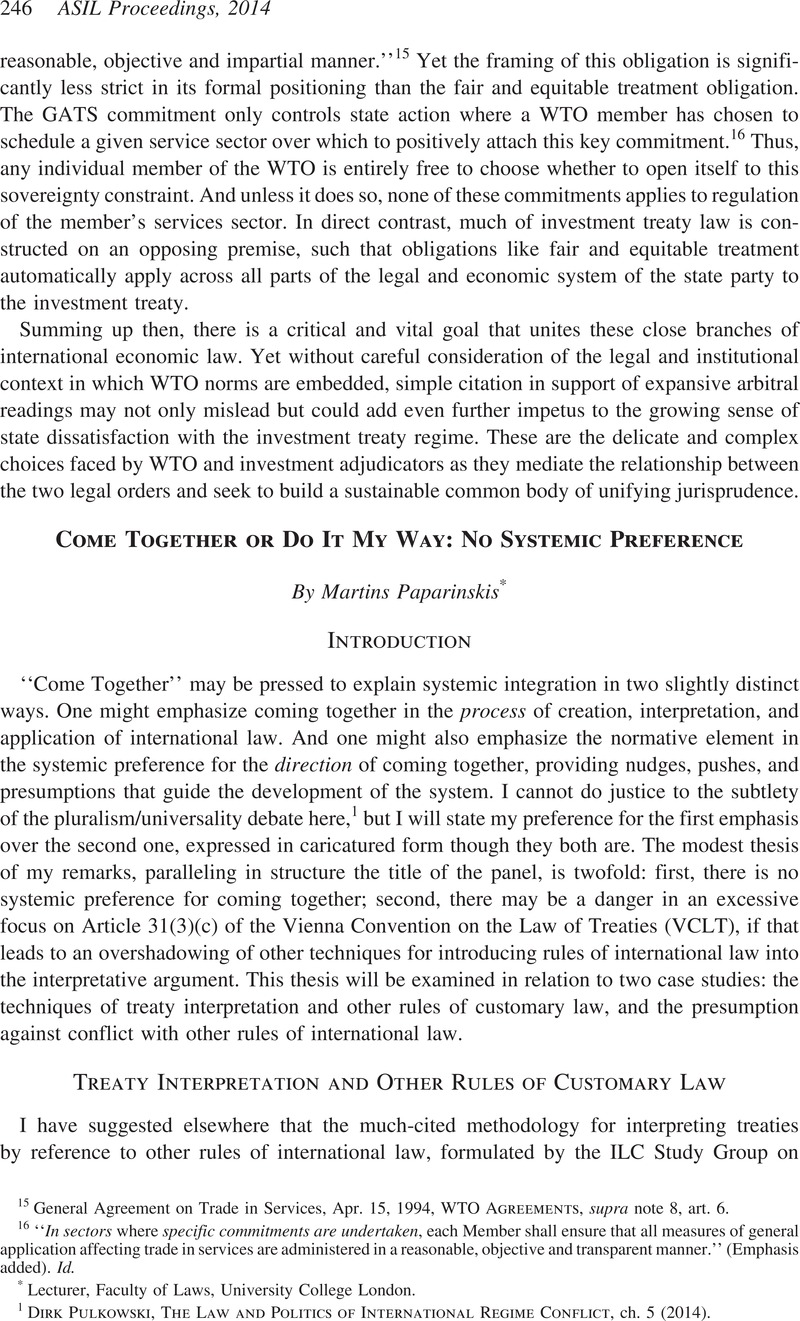No CrossRef data available.
Published online by Cambridge University Press: 20 January 2017

1 Dirk Pulkowski, The Law and Politics of International Regime Conflict, ch. 5 (2014).
2 Conclusions of the Work of the Study Group, Fragmentation of International Law: Difficulties Arising from Diversification and Expansion of International Law, paras. 19(a), 20(a) & (c), UN Doc. A/CN.4/L.682 Add. 1.
3 Paparinskis, Martins, Investment Treaty Interpretation and Customary Investment Law: Preliminary Remarks, in Evolution in Investment Treaty Law and Arbitration 70–80 (Brown, Chester & Miles, Kate eds., 2011)Google Scholar; Martins Paparinskis, The International Minimum Standard and Fair and Equitable Treatment, ch. 6 (2013).
4 Simma, Bruno & Kill, Theodore, Harmonizing Investment Protection and Human Rights: First Steps Towards a Methodology, in International Investment Law for the 21st Century 696 (Binder, Christina et al. eds., 2009)Google Scholar; see also Certain Questions of Mutual Assistance in Criminal Matters (Djibouti v. France), 2008 I.C.J. 177, para. 113; Ambiente Officio v. Argentina, ICSID Case No. ARB/08/9, Decision on Jurisdiction and Admissibility, paras. 599–607 (Feb. 8, 2013).
5 CMS v. Argentina, ICSID Case No. ARB/01/8, Decision on Annulment, paras. 130–31 (Sept. 25, 2007). The Loewen award, if read as relying on the inter-state elements in investor-state arbitration to justify the application of criteria of continuous nationality from diplomatic protection, would fall within the same line of authority. Loewen v. U.S., ICSID Additional Facility Case No. ARB(AF)/98/03, paras. 226, 229–33 (June 26, 2003).
6 Chevron v. Ecuador, UNCITRAL Case, Partial Award on Merits, para. 242 (Mar. 30, 2010).
7 Id. para. 244.
8 Id. paras. 244, 250, 264, 321, 323, 326, 328, 331.
9 VCLT applied as customary law. Id. para. 159.
10 Cf. Ecuador v. U.S., Request for Arbitration and Statement of Claim, paras. 6–11 (June 28, 2011), http://pca-cpa.org/showpage.asp?pag_id=1455; White Industries v. India, UNCITRAL Case, Final Award, para. 11.3 (Nov. 30, 2011).
11 Nada v. Switzerland [GC], Eur. Ct. H.R. 2012, para. 170; see also paras. 81, 169–72.
12 Its rejection in the great Wimbledon judgment provides some cause for caution. S.S. Wimbledon, 1923 PCIJ (ser. A) No. 1, at 24–25 (Aug. 17).
13 The claims were dismissed with prejudice due to partial abandonment and partial settlement, and were never considered on the merits. Foresti v. South Africa, ICSID Case No. ARB(AF)/07/01, Award (Aug. 4, 2010).
14 Simma, Bruno, Foreign Investment Arbitration: A Place for Human Rights?, 60 Int’l & Comp. L.Q. 573, 585–86 (2011)CrossRefGoogle Scholar.
15 Robert Kolb, La bonne foi en droit international public 266–72 (2000).
16 The Right of Passage is best read as making this point. Right of Passage over Indian Territory (Portugal v. India), 1957 I.C.J. 125, at 142.
17 On the value of excuses, see Lowe, Vaughan, Precluding Wrongfulness or Responsibility: A Plea for Excuses, 10 Eur. J. Int’l L. 405 (1999)CrossRefGoogle Scholar.
18 Yeats, W.B., The Second Coming, in The Oxford Book of Twentieth Century English Verse 79 (Larkin, Philip ed., 1973)Google Scholar.
19 T.S. Eliot, The Love Song of J. Alfred Prufrock, in The Oxford Book of Twentieth Century English Verse, id. at 231.
20 Frank Sinatra, My Way (1969).